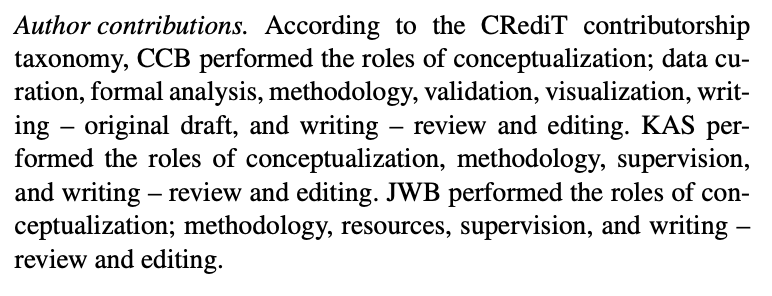Writing your paper: Authorship
Posted 8/12/2024
A few academic papers have thousands of authors, while many others are written by a single person. This vast variation is caused by the many different roles that authors can play. Consider a project where you undertook many research tasks, a colleague provided critical data or samples, another colleague provided an innovative idea that enhanced the study, a friend read a draft to correct some grammar issues, and your advisor proposed the project topic and heavily edited the paper. Are you all authors?
Authorship requirements
Modern best practice considers concrete roles and requirements associated with authorship rather than making decisions emotionally. The Contributor Role Taxonomy CRediT defines 14 types of research contributions that may be related to authorship. Further, many journals specify the requirements for being a paper author (example, example). Typical requirements are that all authors:
Contribute substantially to the conception, execution, or interpretation of the research, or to the writing, revising, or editing of the paper.
Approve of the submitted and final versions of the paper.
Accept responsibility for the accuracy and integrity of the work and resulting conclusions.
These requirements address both contributions and obligations.
The above best practice is unfortunately not universally followed. Researchers are sometimes rewarded based on the number of papers they publish rather than the ideas they contribute, which creates a perverse incentive to pad author lists and give all involved more items for their CVs. There might be a short-term benefit from “free” extra papers. But in addition to the ethical problem, you risk a loss of reputation from being seen as an authorship inflator or being associated with a problematic paper where you had limited involvement. It should be apparent from the above requirements that the following people are not coauthors:
An administrator, such as a department chair or center director, who didn’t contribute intellectually to the research or paper.
A colleague who provided minor help, such as offering feedback on a paper draft.
A long-time collaborator who has co-authored previous papers with you but did not substantially contribute to the present paper.
It may be appropriate to thank such people in the acknowledgments section of the paper.
Conversely, consider whether any other colleagues may have made a substantive contribution to the research (e.g., providing valuable input data, doing fieldwork, or providing important expertise) and might deserve an invitation to co-author.
Author ordering
The order of authorship signals the degree of contribution. The first (or “lead”) author has made the greatest overall contribution to the work, typically in both research and writing. This would be a typical role for a graduate student publishing their thesis work. Some journals allow the designation of “co-lead” authors in cases of equal contribution by two authors, though the frequency of this practice varies by field.
Faculty advisors generally take a later authorship position, even if they contribute substantially, in recognition of their role as advisors rather than research leads (though an advisor might assume the lead author role in cases where their contributions are genuinely primary or where the advisee does not finish the research or writing and the advisor brings the work to completion). In my field, it is common for the advisor of the lead author to take the last author position or perhaps the second position.
Other authorship positions may be specified by relative contribution, with an earlier position indicating a more significant contribution. If it is difficult to distinguish differential contributions, alphabetical ordering or a rotating ordering across multiple publications may be used. There are sometimes discipline-specific conventions for author ordering, so discuss this topic with advisors or senior colleagues or consult the author guidelines for your target journal if you are unsure.
An increasingly common practice is to list specifically what each author has contributed in the manuscript (see example below). This can document the complex contributions of multiple authors and make it a little more difficult to add extra authors unethically. However, the publications list in your CV will only show the author order without details about roles, so it is still worthwhile to consider proper ordering.

An example summary of author contributions in a manuscript.
Discussing authorship
For students authoring only with their advisor, an authorship conversation may be a simple confirmation before starting a paper draft. Complex projects require more care about when and with whom to have authorship conversations. Teams planning from a large project may even need to simultaneously decide on the multiple planned papers’ scopes and author orderings.
When in doubt, start this conversation early—ideally near the beginning of the project when roles are being established and certainly by the start of paper writing. To keep decisions focused on concrete criteria rather than subjective judgments, it can be helpful to use the CRediT scheme and discuss the roles and responsibilities of all participants. It may also be productive to create an authorship agreement. These conversations can be challenging if you are a graduate student or junior researcher due to your power differential with co-authors and limited experience. Hopefully a senior academic advisor or project manager will assist and provide guidance on norms in the field. You can always request that they initiate and facilitate the conversation.
Authorship sometimes changes late in the process. The paper’s scope may evolve and trigger a revision of author roles. (I once worked on a paper where the scope I contributed was removed during the review process, so I dropped out as an author. Another time, a colleague provided a great idea for a draft paper we circulated, which triggered further analysis and resulted in us adding her to the author list.) Sometimes, a planned author does not fulfill their commitments, and it may be appropriate to drop them if they didn’t contribute meaningfully and haven’t accepted responsibility for the presented work. In such cases, the early conversation about planned contributions can highlight how the situation has changed.
Author responsibilities
First authorship is both an honor and an obligation. You need to carry the work forward, coordinate the writing and editing process, and often handle the correspondence with the journal. Especially for a multi-author or multi-institution team, this coordination and communication can take significant time and effort). The effort may be valuable when the work is a key part of your goals and you lead the research. However, for side projects with other potential first authors, consider that taking a secondary position may significantly reduce your work and allow you to devote more time to your primary projects.
Another management role is the “corresponding author,” who submits the paper and handles all journal correspondence and administration. This is an administrative rather than scholarly role and so this designation doesn’t carry academic value. The role is often covered by the first author, since they are typically already coordinating paper feedback and updates within the author team. But it could be someone else, for example the advisor in the case where the first author is a student who has moved on to a new job.
If you are leading a paper, put your co-authors to work! They are signed on to the team, so take advantage of their capabilities. If they contributed some part of the research results, ask for help with the paper’s corresponding writing and figures. Co-authors should also provide feedback on multiple paper drafts, and the lead author should thoughtfully consider and reconcile this feedback. Establishing your author team early lets you utilize their expertise to improve the paper.
If you are the lead author, don’t feel guilty about bugging your co-authors to edit or approve paper drafts. You are obligated to give them drafts sufficient to edit productively, and you should keep in mind that their work will need to be scheduled alongside other obligations. But when they agree to co-author, they agree to support and approve the paper, so your prompting is a reminder of this obligation rather than a request for a new favor.
Conclusion
Authorship planning, while sometimes straightforward, can become complex in collaborative research. For consistency and fairness, it is crucial to approach authorship deliberately and transparently. Four steps to do this are:
Think concretely about authorship roles using frameworks like CRediT.
Discuss roles with potential coauthors early in the research process.
Document agreements, especially for complex projects.
Be prepared to revisit authorship if project scope changes significantly.
By following these guidelines, researchers can foster positive collaborations, ensure appropriate credit, and uphold the ethical standards of scientific publication.

Register
Use the following link to register to receive very occasional updates about new offerings on this page. I will not share your information with anyone.